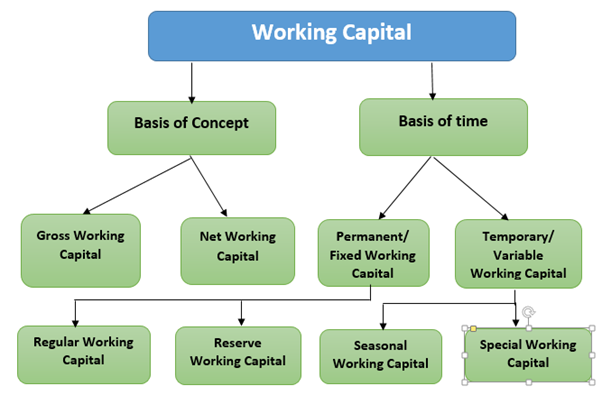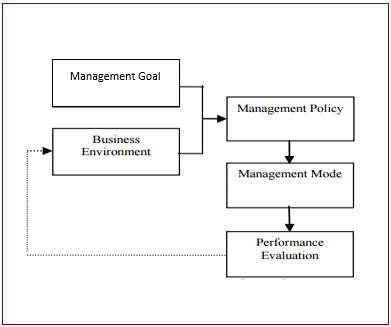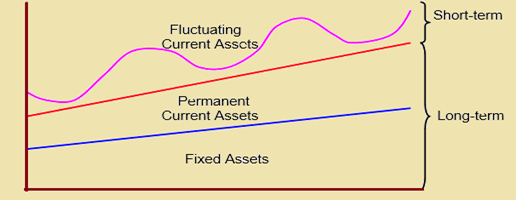Working Capital Management
Working capital is an economic metrics that signifies the operational liquidity of a commerce, organization, or other entity. It is most significant constituents of finance matters in companies in working capital management, which has a direct impact on productivity and liquidity of company. Working capital sanctioned the company's ability to continue its activities without jeopardising liquidity. Working capital management is very important due to its effect on risk and profitability of company and thus the value of the company (Izadinia and Taki, 2010). Along with fixed assets, such as property, plant, and equipment, working capital is considered a part of operating capital. Positive working capital is essential to ensure that a firm is able to continue its operations and has adequate funds to satisfy both maturing short-term debt and forthcoming operational expenses. A company can be endowed with assets and success but short on liquidity if its assets cannot be changed into cash. In financial literature, working capital described as that part of the firm's capital, which is essential for financing short-term or current assets such a cash marketable securities, debtors and inventories. Funds invested in current assets keep revolving fast and are constantly converted into cash and this cash flow out again in exchange for other current assets (Hrishikes Bhattacharya, 2009).
Working Capital = Current Assets - Current Liabilities
Working Capital is also known as turning or circulating capital or short-term capital. George William Collins stated that working capital is the part of current assets exceed current liabilities, which is defined as net working capital. Hyun-Han Shin and Luc Soenen stressed that effective working capital management should think of shareholders' value (1988). There are two concepts of working capital, Gross and Net. Gross working capital means the total current assets. Net working capital can be elaborated in two ways, the difference between current assets and current liabilities and the portion of current assets which is financed with long term funds.
Effectual working capital management needs an overall examination on the environment, like economic environment, industrial characteristics and its own characteristics. Efficient working capital management mode may base on distribution channel or value chain which focuses on up and downstream management, as well as the internal production link (Z. Xia and S. Shu-hua, 2009). The commercial credit helps to accelerate cash flow, then to realize the efficient working capital management. With the opening international markets and a growing application of financial derivatives, Wang Zhuquan introduced several innovative modes for working capital management, such as export credit insurance, repurchase guarantee sales (W. Zhu-quan and L. Wen-jing, 2009). It has been documented in studies that well-organized working capital management include planning and control of current assets and current liabilities in destroying risk of company's ability to meet short- term commitments in one hand, and in the other hand prevention at excess investing of assets.
In financial literature, Working capital management is not new issue. It has been shown in studies that there is an important relationship between the performance and working capital management by using different variables for the analysis. Researchers have stated concept of working capital management in different ways that it is efficient management of cash assets and liabilities (Eljelly, 2004).
Kinds of working capital

The prime objective of working capital management is to guarantee smooth operating cycle of the business. Secondary objectives are to optimize the level of working capital and minimize the cost of such funds.
Building a working capital management system is to support the management and make it more systematic. Furthermore, an effectual management system should be appropriate to all types of working capital management practices, and be constantly reparable. To meet this requirement, a management system is proposed which is based on the performance management theory. In particular, the system include the following five consistent elements that include management goal, business environment, management policy, management mode, and performance evaluation.
The Relationship between five elements of working capital management system

Uses of Working Capital:
Net working capital is calculated as current assets minus current liabilities. It is a derivation of working capital commonly used in valuation techniques such as discounted cash flows (DCFs). If current assets are less than current liabilities, an entity has a working capital deficiency, also called a working capital deficit. The ability to meet the current portion of debt (payable within 12 months) is critical because it signifies a short-term claim to current assets and is often secured by long term assets. Common types of short-term debt are bank loans and lines of credit.
Working capital management involves the process of balancing the needs of short-term assets and short-term liabilities. Assets and liabilities must be matched and synchronized in order to maintain low costs and to control risks. Decisions relating to working capital and short term financing are referred to as working capital management.
These involve managing the relationship between a firm's short-term assets and its short-term liabilities.

Components of Working Capital
- Cash: Cash is perhaps the least productive asset.
- Marketable Securities: Marketable securities are a way to hold cash but with the attribute of earning interest. Market securities have three features:
- Short-term maturity (less than one year, or "money market instruments"
- High marketability
- Virtually no risk of default
- Accounts Receivable: Accounts receivable are created when a firm offers credit to its clienteles. The use of such credits generates receivables, known as account receivable.
Source: Lorenzo Preve, 2010

This equation shows that firm's receivable are directly related to the level of the firm's sale and the number of days the firm allows its customer to take to pay their invoices.
Factor that must be addressed when establishing a credit policy is to set the standards by which a firm is judged in determining whether or not credit will be extended. There is 5 Cs of credit:
- Character: The willingness of the borrower to repay the obligation.
- Capacity: The capability of the borrower to earn the money to repay the obligation.
- Capital: Adequate assets available to support operations (as opposed to a firm that is undercapitalized). Sometimes capital is understood to mean equity capital i.e. to make sure the owners of the firm have sufficient money at stake to give them proper incentive to repay the loan and not let the company go bankrupt.
- Collateral: Assets to support the loan which can be liquidated if default occurs.
- Conditions: Current and future anticipated conditions of the firm and the industry.
- Inventories: Inventories such as raw materials, work-in-process, finished goods, make up a huge percentage of most firm's current assets, and for many, total assets. As such, the extent to which a firm resourcefully manages its inventories can have great influence on its productivity. Thus, keeping well-informed of inventory strategy is critical to the success of the firm.
- Flow of funds: Flow of funds through an organizations encompasses all segments of corporations and is related to all decisions with in firm. It is one of the main concern of the cash manager.
Flow of funds (Source: Cheng-Few Lee, Alice C. Lee, 2006)

The major goal of working capital management is to make certain that the firm must develop competency to continue its operations and that it has plenty cash flow to satisfy both maturing short-term debt and upcoming operational expenses. Working capital management involves short-term decisions, usually relating to the next one-year period and are based in part on cash flows and/or success.
Characteristics of working capital management include short-term loans, merchandise purchased on credit, goods and services provided on credit and merchandise, goods and services paid for upon delivery. Managing working capital essentially involves managing the cash flow of a business on a daily, weekly and monthly basis in such a way that satiates all debts while reserving enough capital to continue operations and the generation of revenues.
Importance of Working Capital Management
- In a typical manufacturing firm, current assets exceed one-half of total assets.
- Excessive levels can result in a substandard Return on Investment (ROI).
- Current liabilities are the principal source of external financing for small firms.
- Requires continuous, day-to-day managerial supervision.
- Working capital management affects the company's risk, return, and share price.
Evaluation of Working Capital Management
There are several factors that influence the assessment of working capital requirement of company (Satish B. Mathur, 2007). These are mentioned below:
- Nature of business
- Seasonal industries
- Production policy
- Market conditions
- Supply conditions
Cash flows can be gauged using the cash conversion cycle, the net number of days from the outlay of cash for raw material to receiving payment from the customer. Because this number effectively corresponds to the time that the firm's cash is tied up in operations and unavailable for other activities, management generally aims for a low net count.
Cost-effectiveness can be evaluated by considering at return on capital (ROC). This metric is determined by dividing relevant income for the 12 months by the cost of capital used. When ROC exceeds the cost of capital, firm value is enhanced and profits are expected in the short term.
Advantages of Adequate Working Capital
- Supports in maintaining goodwill of the firm.
- Assists in maintaining solvency of the firm.
- Helps the firm in getting regular supply of raw material.
- Helps the firm in getting regular return on investment.
- Helps the firm in getting payment.
- Helps the firm to face the crisis.
- Helps the firm in getting loan easily from the banks.
- Helps the firm in getting cash discount.
Disadvantages of Inadequate Working Capital
- It leads to unnecessary debtors.
- Spare funds are not usable and do not generate profit.
- Firm fails to maintain the relationship with the banks due to non-requirement of funds.
- Leads to unnecessary buying.
To summarize, working capital is explained by economists as the firm's investment in short-term assets (cash, marketable securities, accounts receivable and inventories). Working capital management is concerned with the problems that rise in attempting to manage the current assets, the current liabilities and the interrelations that exist between them. Major objectives of working capital management is to manage the firm's current assets and liabilities in such a way that an acceptable level of working capital is maintained. The interaction between current assets and current liabilities is the main refrain of the theory of the working capital management.

